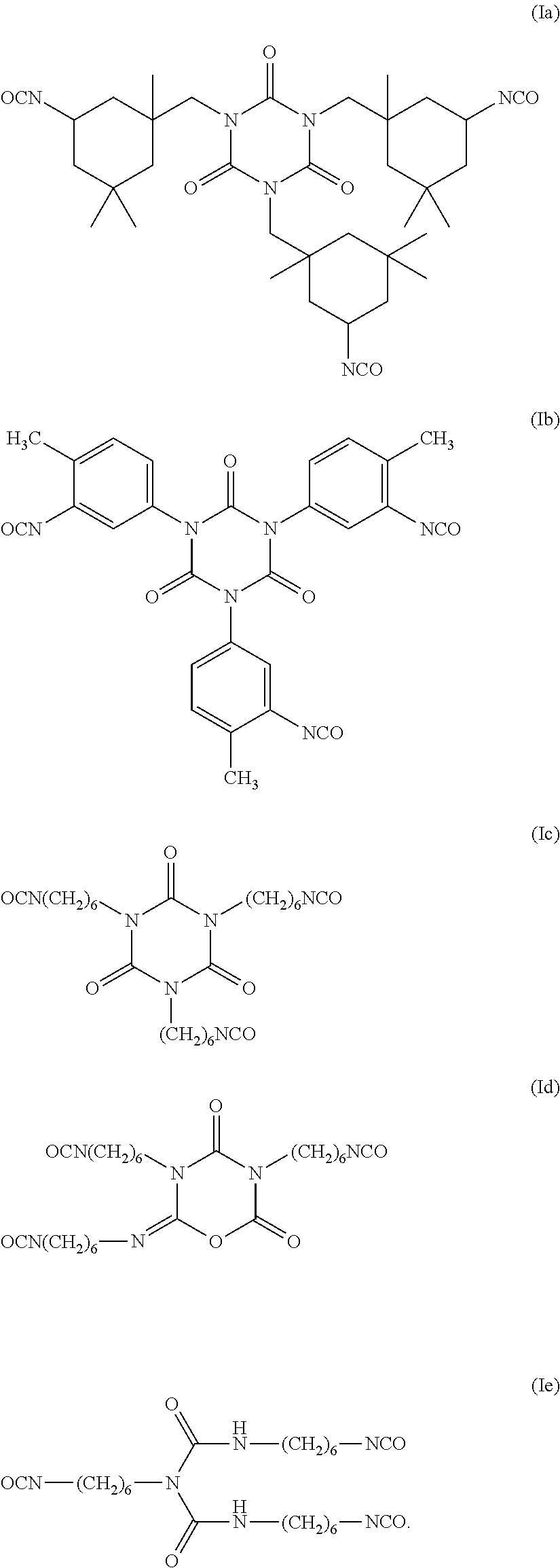Partially fluorinated urethane based coatings
a technology of urethane and coating, which is applied in the direction of coating, fibre treatment, liquid repellent fibre, etc., can solve the problem of less effective than the fluorinated counterpar
- Summary
- Abstract
- Description
- Claims
- Application Information
AI Technical Summary
Benefits of technology
Problems solved by technology
Method used
Image
Examples
examples 1-10
[0080]The following general procedure was followed to produce the samples for Examples 1-10. Amounts of each compound are shown in Table 2.
[0081]In a small vial equipped with a stir bar and nitrogen flow was added compound (b), compound (c) and 4-methyl-2-pentanone (MIBK, 150 g) and heated to 55° C. Once the temperature was stabilized, compound (a) was added and the solution was heated to 80° C. Next, catalyst was added and the temperature was increased to 95° C. After 4 hours, n-butanol was added. The temperature was then decreased to 80° C. and held overnight. The next morning, products were tested for the presence of active isocyanates and then applied to cotton and polyester at 100 g / L.
[0082]
TABLE 2Compositions of Examples 1 to 10.FluorinatedIsocy-reagent (c)Addi-anate (a)1H,1H,2H,2H -tionalDESMO-Perfluoro-SugarMonomerDUR N100hexanolAlcohol (b)Wt.N-ButanolEx.(Wt. %)(Wt. %)Reagent%(Wt. %)123.58.1sorbitan66.91.5tristearate233.632.8sorbitan30.92.7tristerate327.727.9TWEEN 6542.51.94...
examples 11 to 27
[0084]Examples 11 to 27 follow the procedures of Examples 1-10, using the compounds shown in Table 4. Examples 11 to 27 were applied to cotton and polyester textiles at 100 g / L. The fabrics were tested according to the test methods described above. Performance data is shown in Table 5.
[0085]
TABLE 4Compositions of Examples 11 to 27SugarIsocyanateAlcohol (b)Additional(a)SorbitanFluorinated reagentMonomerDESMODURtristerate(c)N-ButanolEx.N100 (Wt. %)(Wt. %)ReagentWt. %(Wt. %)1123.964.6Perfluorobutylthio-10.11.4ether ethyl alcohol1223.864.5C4,1-VDF Alcohol10.21.41323.964.6Perfluorobutylthio-10.21.4ether ethyl amine1423.864.5PPVE alcohol10.31.41523.262.7Perfluorohexylthio-12.91.4ether ethyl alcohol1623.262.7Perfluorobutylthio-12.81.4ether ethyl amine1715.742.4KRYTOX KFA-41.00.9220AL1823.663.8Perfluorhexylethyl11.21.4amine1925.268.31-Butanol, 3,4,4,4-5.01.5tetrafluoro-3-(trifluoromethyl)2025.268.11-pentanol, 4,5,5,5-5.31.5tetrafluoro-4-(trifluoromethyl)2123.864.3N-methyl-RF6-10.61.4sulfona...
examples 28 to 32
[0087]The following general procedure was followed to produce the samples for Examples 32 to 36.
[0088]Into a 4-neck round bottom stirrer, thermocouple and condenser was added the compound (b), compound (c), sodium carbonate and MIBK and heated to 55° C. Once the temperature was stabilized, compound (a) was added and the solution was heated to 800 C. Next, Fe3Cl catalyst was added and the temperature was increased to 95 C. After 6 hours, n-butanol was added to the reaction mixture and the temperature was lowered to 80 C and held overnight.
[0089]In the morning an aqueous surfactant solution containing water (122.8 grams), acetic acid (0.86 gram), Chemdix S (1.23 grams), Ethal LA-4 (1.61 grams) and dipropylene glycol (13.92 grams) was prepared. The solution was heated to 65 C. The solution was then slowly added to the reactor producing a milky dispersion. The mixture was immersion blended (2 minutes), homogenized at 6000 psi, and then distilled under reduced pressure to remove the solv...
PUM
| Property | Measurement | Unit |
|---|---|---|
| temperature | aaaaa | aaaaa |
| temperature | aaaaa | aaaaa |
| diameter | aaaaa | aaaaa |
Abstract
Description
Claims
Application Information
 Login to View More
Login to View More - R&D
- Intellectual Property
- Life Sciences
- Materials
- Tech Scout
- Unparalleled Data Quality
- Higher Quality Content
- 60% Fewer Hallucinations
Browse by: Latest US Patents, China's latest patents, Technical Efficacy Thesaurus, Application Domain, Technology Topic, Popular Technical Reports.
© 2025 PatSnap. All rights reserved.Legal|Privacy policy|Modern Slavery Act Transparency Statement|Sitemap|About US| Contact US: help@patsnap.com



